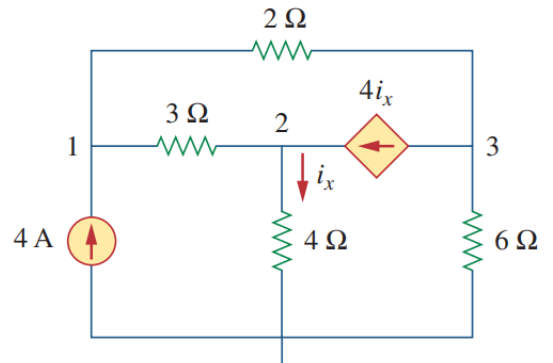Analyze the circuit to find the current ix.

Understand the Problem
The question involves analyzing an electrical circuit with multiple resistances and a current source. The problem likely requires applying techniques like Kirchhoff's laws or mesh analysis to find the unknown current, denoted as ix, in the circuit.
Answer
The value of the current $i_x$ is $-1.5 \, A$.
Answer for screen readers
The value of the current $i_x$ is $-1.5 , A$.
Steps to Solve
-
Identify the Components and Directions Label the currents in the circuit. Assume current $i_x$ flows through the specific element, and note that the current entering a junction must equal the current leaving the junction (Kirchhoff’s Current Law).
-
Apply Kirchhoff’s Current Law (KCL) At junction 3, the currents can be summed. If $4A$ enters node 1, the equation will be: $$ 4A = i_x + i_{next} $$ where $i_{next}$ is the current leaving node 3.
-
Set up the Voltage Equation For the mesh including resistors and current sources, apply Kirchhoff’s Voltage Law (KVL). Choose a loop that includes the voltage sources and resistances. For example, if going clockwise: $$ -4A \cdot 2,\Omega - i_x \cdot 4,\Omega + 2 = 0 $$
-
Substitute and Solve for (i_x) Substituting values into the KVL equation gives you an expression for $i_x$: $$ -8 - 4i_x + 2 = 0 $$ Combine like terms: $$ -4i_x - 6 = 0 $$
-
Simplify and Find (i_x) Now solve for $i_x$: $$ -4i_x = 6 $$ $$ i_x = -\frac{6}{4} = -1.5A $$
-
Interpret the Result The negative sign indicates that the direction of $i_x$ is opposite to the assumed direction in the beginning.
The value of the current $i_x$ is $-1.5 , A$.
More Information
The result indicates that the actual current flows in the opposite direction compared to the initial assumption made for $i_x$. Understanding current directions is crucial in circuit analysis.
Tips
- Misapplying KCL by incorrectly summing the currents at the junctions.
- Neglecting to correctly apply KVL for the voltage around a loop.
- Not accounting for the signs of current when substituting values.